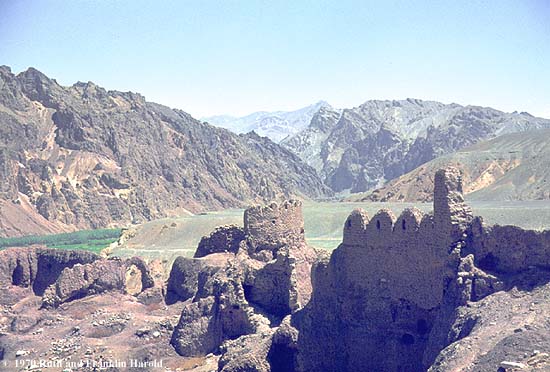
Recovery would be slow. Forty years after the disaster, Juvaini found Bamiyan still a ghost town.
Rebuilding took place in the 15t century, under the Timurid kings; Babur, with his keen eye for natural beauty,
was much taken with Bamiyan.
But by then the caravan trade was in terminal decline.
As an agricultural and pastoral region, the valley became a stronghold of the Afghan monarchy; and eventually caught the roving eyes of a new breed of pious pilgrims, the serious travellers.
The magnet is, or rather was, the gigantic statues of Buddha carved out of the cliff.
One stood 120 feet tall, the other 175; each occupied a trilobed niche whose arches were decorated with colored frescoes.
In their day, the statues too were brightly painted.
The niches are flanked by dozens of artificial caves, many adorned with frescoes, all part of that huge monastic ensemble.
Scholars have discerned stylistic influences from Gupta India and Sassanian Iran, and these allow one to venture some dates. The Buddhas are presently assigned to the 5th and 6th centuries C.E. ( earlier authors often preferred dates a couple of centuries earlier, e.g, Dupree,1967).
Some of the painted caves may be later still.
Neither the monasteries nor the royal city at the foot of the cliff has been excavated, but visitors found much
food for thought in the Islamic city ( Shahr-i-Gholghola) and its outlying fortress ( Shahr-i-Zohak).
Presently, it is said, both are still packed with landmines; Ghengis Khan would be pleased.
Sources
For a brief summary of the history of Bamiyan and its monuments see the article by X. de Planhol in the Encyclopaedia Iranica.
For the Kushans see J. Keay, India, A History (Grove Press, New York, 2000).
There is a good survey of Gandharan art in R.E. Fisher, Buddhist Art and Architecture
(Thames and Hudson, London, 1993).
During our visit to Bamiyan in 1970 we relied on a small guide by Nancy Hatch Dupree,
(The Valley of Bamian, Afghan Tourist Organization, 1967).
© 2006 Frank Harold.
Silk Road Seattle is a project of the
Walter Chapin Simpson Center for the Humanities at the
University of Washington.
Additional funding has been provided by the Silkroad Foundation
(Saratoga, California).
http://depts.washington.edu/silkroad/cities/afghanistan/bamiyan.html